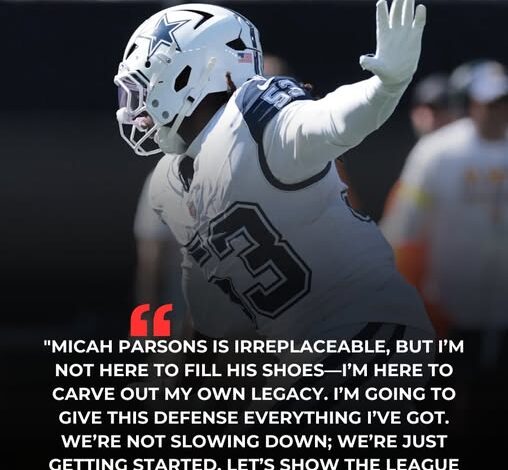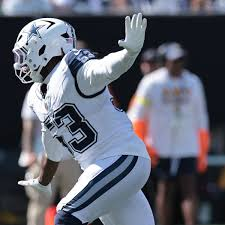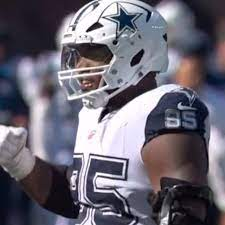ql.“The Cowboys Don’t Need Micah Parsons to Dominate Anymore?”Explosive 2025 Rookie Is Making Dallas Forget Its No. 1 Defensive Star — and Fans Are WildlyDivided! Who Is the True Heart of the Cowboys Now?

The Cowboys Don’t Need Micah Parsons to Dominate Anymore?
The Explosive 2025 Rookie Is Making Dallas Forget Its No. 1 Defensive Star — and Fans Are Wildly Divided! 💥
Who Is the True Heart of the Cowboys Now?

Introduction
In 2025, the NFL world watched in stunned silence as the Dallas Cowboys dealt away their defensive crown jewel, Micah Parsons. The blockbuster trade to the Green Bay Packers stunned fans, analysts, and even some within the league.
That move raises a provocative question: Does Dallas still need Parsons to dominate? As new faces step into the spotlight, the Cowboys roster is undergoing a seismic shift. And with it comes heated debates—some claim Parsons was irreplaceable, others insist that leadership and “heart” now rest somewhere else.
Let’s dive in.

The Micah Parsons Legacy — Before the Trade
Before departing Dallas, Parsons was more than just a standout defender. He was the defense. His presence altered schemes, forced offenses to double-dip protection, and anchored rotation strategies for the Cowboys.
- Over the years, Dallas’ defense was often their best unit when Parsons was active. According to ESPN, in the four seasons leading up to the trade, the Cowboys ranked first in defensive EPA per play when Parsons was on the field; when he was off, they fell to among the worst.
- He consistently ranked among league leaders in pressure percentage and pass-rush metrics.
- Coaches tailored their defensive rotations around him. He had the freedom to “stunt,” drop, or rush aggressively because his teammates filled gaps around him.
To many Dallas faithful, he was the heartbeat of the defense—the emotional and physical core.
Why Dallas Traded Him
It’s tempting to chalk Parsons’ exit up to drama or a misunderstanding, but the trade stems from deeper structural and philosophical decisions:
- Contract Gridlock & Cap Constraints
- Parsons’ contract demands became a sticking point. The Cowboys reportedly offered what would have been the most guaranteed money ever for a non-quarterback, but negotiations stalled.
- From a roster-construction standpoint, keeping Parsons meant allocating a massive percentage of the cap to one defensive player—limiting flexibility elsewhere.
- Risk vs. Reward
- Parsons’ elite performance came with injury risk, and his absence had historically collapsed Dallas’ defense. The front office may have seen the long-term downside.
- By trading him while still near his prime, Dallas acquired two first-round picks and a premier defensive tackle, Kenny Clark.
- Belief in System Over Singular Talent
- The Cowboys’ defensive staff has long preached that a well-built system and depth can outlast reliance on one superstar. With improved depth at edge and interior line, they might believe they can adapt.
- The front office likely believes that “soldier next man up” is sustainable if the roster has been upgraded correctly.
In short: Dallas bet on the infrastructure rather than a single star.
The 2025 Roster Shake-Up — Who’s Drinking from the Cup Now?
With Parsons gone, new players are shouldering expectations they never asked for. Among them:
- James Houston — A breakout edge piece. In limited pass-rush snaps, he’s shown the burst and timing to be a key piece.
- Donovan Ezeiruaku — Drafted to diversify pressure from the opposite side. He’s shown flashes in rookie reports and is being groomed for bigger roles.
- Dante Fowler Jr. — Brought back to give veteran scheme versatility and help mentor younger rushers.
- Interior Line Upgrades — The trade gave Dallas Kenny Clark, and the interior defensive front is tasked with eating blocks so edge men can chase.
- Depth Matters — Marshawn Kneeland, Sam Williams, and others are being asked to step up or risk exposure.
All told, Dallas now fields a more committee-style defensive front—less built around one person and more on rotation, matchup advantages, and schematic flexibility.
The Fan Divide — Who’s Winning the Narrative?
Even as Week 5 of the 2025 season unfolds, the debate is ferocious:
- Pro-Parsons camp laments that nothing replaces a talent like Parsons: the emotional spark, the fear factor, the single-player-altering game. Some argue Dallas will be “average” or worse on defense without him.
- Anti-Parsons / Front-Office believers counter that relying too heavily on one star is a recipe for collapse when injuries or contract disputes emerge. They point to the draft picks acquired and believe Dallas can pivot without missing a beat.
In digital spaces, the tension is tangible:
- Some fans cite Parsons’ legacy in rankings
- Others applaud the more balanced, next-man-up ethos.
Who Is the True “Heart” of the Cowboys in 2025?
If we’re looking for a successor to Parsons’ emotional and strategic impact, here are contender identities:
- Dak Prescott (Offense → Team Identity)
- As quarterback and franchise face, Prescott has always been the emotional anchor. Many would argue the “heart” of the Cowboys is on offense, not defense.
- His performance often dictates how comfortably the defense can play.
- James Houston / Ezeiruaku (Defensive Emergence)
- If one of them breaks out and forces offenses to account for him, that would help fill Parsons’ void.
- In particular, Houston’s efficiency in pressure snaps makes him a favorite among analytics watchers.
- Team Culture & Coaching (Collective Heart)
- Dallas might be shifting toward a more collective concept: not one face, but a group identity—resilient, deep, opportunistic.
- Leadership may now come from multiple voices, not just one dominant star.
- Veteran Linemen / Interior Mentors
- The likes of Clark or Fowler might become the glue—setting tone in the trenches, leading by example.
So the “heart” in 2025 may not be one person—it may be the system itself, or a shared identity among defensive playmakers.
Risks & Wildcards
- Injuries or regression — Without a sure-fire ace, depth is tested. If Houston or others stumble, the loss of Parsons will feel heavier.
- Fan patience may wane — Expectations remain high in Dallas. Struggles will rapidly intensify criticism.
- Matchup failures — Some offenses might scheme specifically to avoid pressure, knowing Dallas lacks the fear-factor edge rusher.
- Emotional void — Parsons wasn’t just a playmaker; he was a rallying point. That intangible leadership is hard to replicate.
Final Verdict (for Now)
Does Dallas need Micah Parsons to dominate? In 2025, the Cowboys are betting no. They’re trying to prove that a balanced, well-engineered defensive unit can withstand the departure of a superstar.
But the transition will not be instantaneous or painless. Parsons leaves a legacy, a vacuum, and a standard. Whether James Houston or Donovan Ezeiruaku—or perhaps even the collective front—can step into that role remains to be seen.
The “true heart” of the Cowboys may lie not in a single jersey number, but in how the roster adapts, breathes, and fights together. If that experiment succeeds, Dallas may not regret trading away its marquee defender. If it fails, the longing for Micah Parsons will be felt loud and long.

